Depth of
Field
(More information
is available
in the PIM site on this specific topic)
When you focus on your subject, you will find that not only is the subject itself
in focus but objects in a certain distance range both in front of and behind the
subject appear reasonably sharp. This in-focus zone is known as "depth of field."
Control of depth of field enables selective blurring of the background elements of
a picture or letting the major subject stand out. You can check the background image
as the result by pressing the depth-of-field preview lever. The depth of field changes
depending on three factors; aperture, focal length lens, and shooting distance. 1)The
wider the aperture opening, the shallower the depth of field, and the smaller the
aperture opening, the deeper the depth of field.
1) The wider the aperture opening, the shallower the depth of field, and the smaller
the aperture opening, the deeper the depth of field.
2) The longer the focal length (such as with a telephoto lens), the shallower the
depth of field, and the shorter the focal length (as with a wide-angle lens), the
greater the depth of field.
3) The closer the subject is to the lens, the shallower the depth of field, and the
farther away the subject is from the lens, the greater the depth of field.
Note: Controlling the depth
of field gives your picture its own character.
Light-Metering Methods
Full-Aperture
Metering*: This camera employs
TTL full-aperture metering to determine the exposure by measuring the brightness
of subjects through the lens, using a built-in sensor. With an Ai-type lens attached,
full-aperture metering is performed, and you can set the exposure while maintaining
full brightness in the viewfinder.
*
Full-aperture
metering is a light-metering system of a camera with a built-in TTL exposure meter.
With this system, the exposure meter of the camera always measures the light with
full aperture. With the lens aperture set at full opening, the specified aperture
value is mechanically or electrically transferred to the light-metering mechanism
to control the light entering through the lens when shooting. On the contrary, metering
the light with the actual aperture setting for shooting is called "stop-down
metering."
This may darken the viewfinder disturbing easy focusing. With a special lens or a
certain accessory (such as a bellows attachment), only stop-down metering is valid.
Stop-down metering: This method is used when the meter
coupling lever does not operate in synchronization with the lens aperture. In this
method, the light is measured after making the aperture setting for actual shooting
when a Non-Ai-type lens or close-up ring is used. To use Stop Down Metering, keep
depressing the depth of field preview lever while turning the aperture on the lens
to get the meter reading. WARNING: DO NOT use
this method
to meter if your Nikkor lens is an Ai-type and directly mounted on a FM3A as the
metering provided will
not be accurate.
Optional Accessories
Nikon has, over the years built a mini system around the mid-range FM/FE series SLR models while on the other hand, the cameras can also tab into and take advantage of the huge Nikon 35mm photographic system components. There are quite a few dedicated system accessories which are tailored designed for the FM and FE bodies which you can use them to enhance capabilities of these Nikons. Some of the more prominent ones are listed below:
Interchangeable Focusing Screens
The Nikon FM3A has a very bright focusing screen called Spliprism-image Rangefinder Microprism screen which comes as a standard. There are two optional screen types with equal brightness which you can consider when situations demands for a change.
 |
 |
 |
Each of them has its own strength to enhance a different degree of photographic experience and to facilitate a more comfortable viewing and/or picture composing with the camera/lenses combination. |
A | separate section is provided | to guide you how to handle screen changing and some clues on their respective applications and/or how to differentiate them with earlier screen types (K2/B2/E2) which were originally designed for the Nikon FM2(n), FE and Nikon FA.
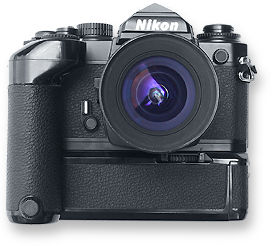 |
MD-12 Motor Drive |
SB-27 Speedlight
• A compact, lightweight flash attachment that enables TTL light metering, external automatic light metering, and manual flash firing.
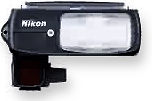 |
• The mounting position of the light-emission block can be changed to horizontal at the right, vertical, or horizontal at the left, so that you can easily control the shadow of the subject. |
• The catch-light effect to reflect part of flash on eyes and the diffuser to soften the characteristics of the light allow additional effects for close-up photography.
• The AF SB-28, SB-23, SB-22 and many older manual focus units are also available. Note: Many different types of MF/AF Nikon Flash Units have been introduced over the years, compatibility, performance and functionality may vary when with the Nikon FM3A and it will be address in a separate issue.
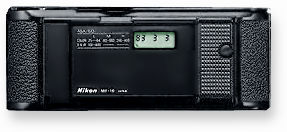 |
MF-16 Data Back |
Camera Case
The CF-27S, CF-28S, and CF-29S semi soft cases are available. The CF-27S case accommodates the camera with a lens smaller than 50 mm f1.4 mounted. The CF-28S is for the camera when mounted with a lens smaller than 50 mm f/1.2 to 105 mm f/2.5. When the MD-12 motor drive is attached to the camera, use the CF-29S. In addition, the CF-28A front cover for a 35-70mm zoom lens is provided.
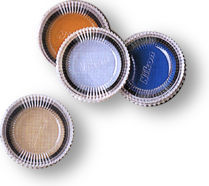 |
Filters for B&W and Color Film Since B&W film does not register colors but only different gradations on a "gray" scale, filters are used to improve contrast or to create special effects. When color film is used under conditions different from those specified, strong color casts are likely to result. Photos taken with this type of film in the morning or late afternoon will have a yellow or red tinge. For slide films, filters are usually used to correct such imbalances with both daylight and tungsten film and restore natural color rendition. Other filters can also be used for creative purposes. |
*
ND filters can
flatly decrease the light level without masking out any specific wavelength (color).
Lenses
45 mm F/2.8P Lens (I
don't have any information, any original image nor experience pertaining to this
new lens, you may feed me if you can).
The information provided is very sketchy.
• Lightweight and super-thin
lens of 17-mm (0.7 in.) total length, optimum as a regular-use lens.
• Minimum shooting distance
of 45 cm (17.7 in.).
• Choice-quality unique
design of metallic silver appearance which provides an ideal combination with the
FM3A camera.
• CPU-incorporated manual-only
operations that can provide all exposure modes (P/ S/A/M) of popular cameras currently
on the market.
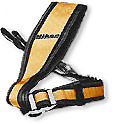 |
A wide variety of lenses - 14 mm to 1000 mm wideangle, telephoto, zoom, Micro or DC (Defocus image Control) - is available for the FM3A. |
0thers
DK-3 Eyepiece Attachment: When attached to the camera's eyepiece, it makes the field of vision in the viewfinder clearer, and may reduce eye strain. The DK-3 is made of rubber.
Eyepiece Correction Lens (for Dioptric adjustment): |
For nearsighted or farsighted photographers. It can be easily attached just by screwing it onto the camera. Nine models (-5, -4, -3, -2, 0, +0.5, +1, +2, or +3) are available. It is recommended to try them before purchasing, as proper Dioptric greatly differs among individuals.
 |
DB-2 Anti-Cold Battery pack: When you use the DB-2 external power supply for the camera body carried in your pocket, power is stably supplied even when the ambient temperature is low. AA-type NiCd, NiMH and Lithium batteries Cannot be Used for this battery pack. When the DB battery pack is mounted to the camera, tripod cannot be used. |
DG-2 Eyepiece Magnifier: Attached to the viewfinder eyepiece, this accessory enlarges the image at the center of the viewfinder to assure ever precise focusing in close-up photography, duplication work and telephotography.
 |
 |
DR-4 Right-Angle Viewing Attachment: Screws onto the viewfinder eyepiece to provide a viewfinder image at a 90 degrees angle to the camera's optical axis, An Adapter Ring DK-13 (optional) is required. I believe the older DR-3 can also be used with the FM3A. |
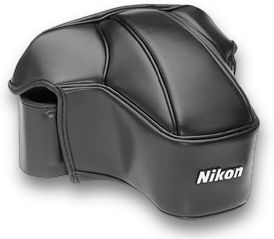 |
CF27S: FM-3A Ever ready case. Use with wide-angle and standard lenses. Model: imitation leather, black |
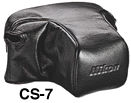 |
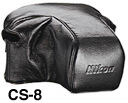 |
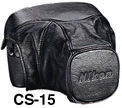 |
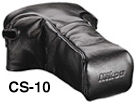 |
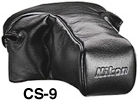 |
Camera Care and Maintenance:
Do NOT use thinner, benzene
or other organic solvents to clean the camera. They may damage the camera, cause
it to catch fire, or harm your health.
Cleaning the camera First lightly blow off dirt and dust with a blower, then
gently wipe the body with a-clean soft cloth. After using the camera near sea water,
wipe the body with a soft cloth slightly moistened with tap water to remove salt,
then lightly wipe it with a dry cloth.
Cleaning the mirror and lens The mirror and lens are very sensitive. Clean
them only by lightly blowing off dust with a blower. If the lens is smeared, such
as with fingerprints, gently wipe it with a clean, soft cloth moistened with commercially
available lens cleaner.
Do NOT
subject
the camera or lens to strong shock such as drop the camera and lens or hit
them against a hard surface. Such strong shock may damage the camera or badly affect
the precisely adjusted parts.
Do NOT
touch the shutter curtains.
The shutter curtains are made of a very thin material. NEVER hold, push, or strongly
blow with a blower. Such actions can crack, deform, or damage the curtains.
Avoid
locations where strong radio waves or strong electromagnetic fields are generated. The camera may not
operate correctly in a location where a strong radio wave or strong electromagnetic
field is generated, such as near a television tower.
Store the camera in a well-ventilated place. To eliminate mold and damage,
store the camera in a dry place with sufficient ventilation.
Do NOT
leave
the camera in a place exposed to chemicals such as camphor or naphthalene, near equipment
generating a strong magnetic emission, in an excessively hot place, such as inside
a car, or in front of a stove in operation.
Avoid
extreme temperature changes.
Extreme temperature changes can cause condensation outside and inside the camera.
When taking the camera to very hot place from a cold place or vice versa, place it
inside an airtight container such as a plastic bag and leave it inside awhile to
expose the camera gradually to the temperature change.
| Previous | Back | 8/8 Index Page of Instruction Manual Section of Nikon FM3A
| Other Issues relate to Nikon
FM3A |< Index
Page >
| Instruction Manual for Nikon FM3A |
Update: found an
External
link in 2005
- Instruction Manual in PDF Format (2.4MB)
| Technical Specification | Main
Reference Map
|
Standard
production Nikon FM Series models:-
Nikon FM | Nikon FM2 | Nikon FM2n | Nikon FM10 | Nikon FM3a |
Known
variants:-
Nikon
FM Gold
| Nikon
FM2/T
| Nikon
FM2N Tropical Set
| Nikon
FM2/T Limited Edition
| Nikon
FM2N LAPITA
|
Nion
FM2n Millennium 2000
| Message Board | for
your favourite Nikon
FM Series SLR models
| Message
Board | for your Nikon
Optics in a shared environment
| Message Board | Specifically for Dispose or Looking for Nikon/Nikkor
Photographic Equipment
| Back | Main Index Page of Nikon FM series Bodies
Shared Resources: MD-11 | MD-12 | Focusing Screens | Titanium Shutter | ORIGINAL dedicated Flash Units -SB-16 | SB-15 | SB-10 or other Options | Databack | Nikkor lens mount (related info)
Others:- Nikon AF-TTL Speedlights
| SB-20 (1986)
|
SB-22
(1987)
| SB-23 | SB-24 (1988) |
SB-25 (1991/2) |
SB-26 (1994)
| SB-27(1997)
| SB-28 (1997) |
Nikon
SB-29(s)
(2000) |
Nikon
SB-30
(2003) |
Nikon
SB-600
(2004) |
Nikon
SB-800 (2003)
(updated)
Nikon AF-TTL Speedlight DX-Series: Nikon SB-28DX (1999)
| SB-50DX (2001) |
SB-80DX
(2002)
(updated)
Nikon
BC-flash Series |
Original Nikon Speedlight
SB-2
| SB-3
| SB-4
| SB-5
| SB-6
| SB-7E
| SB-8E
| SB-9
| SB-E
| SB-10
SB-11
| SB-12 | SB-14 | SB-140 UV-IR| SB-15 | SB16A | SB-17 | SB-18, SB-19 | SB-21A (SB-29) Macro flash | Flash Accesories | SF-1
Pilot Lamp
Instruction
Manual: Nikon FM (HTML | PDF) | Nikon FM-10 (HTML) | Nikon FM2n's
User's Manual
available only in HTML format (6
parts) | Nikon FM3A (HTML)
Specifications: Nikon FM, FM-10, FM2, FM2n and FM3A
Main Reference Map: (HTML) Nikon FM, FM2, FM-10, FM2n (Applicable
to FM2T, FM2 "Year of the Dog"; Millennium 2000") and FM3A
| Nikon F | Nikon F2 | Nikon F3 | Nikon F4 | Nikon F5 | Nikon F6 | Nikkormat / Nikomat | Nikon FM | Nikon FE/ FA | Nikon EM/FG/FG20 | Nikon Digital SLRs | Nikon - Other models |
Nikon Auto Focus Nikkor lenses:- Main Index Page
Nikon Manual Focus Nikkor lenses:- Fisheye-Nikkor Lenses - Circular | Full Frame |
Ultrawides Lenses - 13mm15mm18mm20mm | Wideangle Lenses - 24mm28mm35mm | Standard Lenses - 45mm 50mm 58mm | Telephoto
Lenses - 85mm105mm135mm180mm & 200mm | Super-Telephoto Lenses - 300mm 400mm 500mm 600mm 800mm 1200mm |
 Index Page |
Special
Application lenses: Micro-Nikkor Lenses - 50mm~55mm -60mm 85mm -105mm 200mm Micro-Zoom 70-180mm Perspective Control (PC) - 28mm 35mm PC-Micro 85mm Dedicated Lenses for Nikon F3AF: AF 80mm f/2.8 | AF 200mm f/3.5 EDIF Depth of Field Control (DC): 105mm 135mm Medical Nikkor: 120mm 200mm Reflex-Nikkor Lenses - 500mm 1000mm 2000mm Others: Noct Nikkor | OP-Nikkor | UV Nikkor 55mm 105mm | Focusing Units | Bellows-Nikkor 105mm 135mm Nikon Series E Lenses: 28mm35mm50mm100mm135mm | E-Series Zoom lenses: 36~72mm75~150mm70~210mm |
MF Zoom-Nikkor Lenses: 25~50mm | 28~45mm | 28~50mm | 28~85mm | 35~70mm | 36~72mm E | 35~85mm | 35~105mm | 35~135mm | 35~200mm | 43~86mm | 50~135mm | 50~300mm | 70~210mm E | 75~150mm E | 80~200mm | 85~250mm | 100~300mm | 180~600mm | 200~400mm | 200~600mm | 360~1200mm | 1200~1700mm
Tele-Converters: TC-1 | TC-2 | TC-200 | TC-201 | TC-300 | TC-301 | TC-14 | TC-14A | TC-14B | TC-14C | TC-14E | TC-16 | TC-16A | TC-20E
Recommended links to understand more technical details
related to the Nikkor F-mount and production Serial Number:
http://rick_oleson.tripod.com/index-153.html by: my
friend, Rick Oleson
http://www.zi.ku.dk/personal/lhhansen/photo/fmount.htm by: Hansen,
Lars Holst
http://www.mir.com.my/rb/photography/hardwares/nikonfmount/lens2.htm
http://www.photosynthesis.co.nz/nikon/serialno.html
W A R N I N G: The New G-SERIES Nikkor lenses have no aperture ring on the lens, they CANNOT ADJUST APERTURES with any of these manual focus Nikon FE series SLR camera models; please ignore some portion of the content contained herein this site where it relates.
|
Back | Main Index Page of Nikkor Resources
|
Back | Main Index Page of Pictorial
History of Nikon SLRs
| Message Board | for your Nikkor optics ("shared" because I do wish some of you to expose to other's perspective as well. Isn't it a sad sate to see photography has to be segmented into different camps from the use of various labels)
about this photographic web site
Home - Photography in Malaysia |
Credit: To all the good people who has contributed their own experience, resources or those who are kind enough granting us permission to use their images appeared in this site. Mr. MCLau®, who has helped to rewrite some of the content appeared this site. Chuck Hester® who has been helping me all along with the development of all these Nikon websites;LarsHolst Hansen, 'Hawkeye' who shares the same passion I have; Ms Rissa, Sales manager from Nikon Corporation Malaysia for granting permission to use some of the official content; TedWengelaar,Holland who has helped to provide many useful input relating to older Nikkor lenses; Some of the references on production serial numbers used in this site were extracted from Roland Vink's website; HiuraShinsaku from Nikomat Club Japan. t is also a site to remember a long lost friend on the Net. Note:certain content and images appeared in this site were either scanned from official marketing leaflets, brochures, sales manuals or publications published by Nikon over the years and/or contribution from surfers who claimed originality of their work for educational purposes. The creator of the site will not be responsible for may discrepancies arise from such dispute except rectifying them after verification."Nikon", "Nikkormat", "Nippon Kokagu KK" & "Nikkor" are registered tradename of Nikon Corporation Inc., Japan. Site made with an Apple IMac.